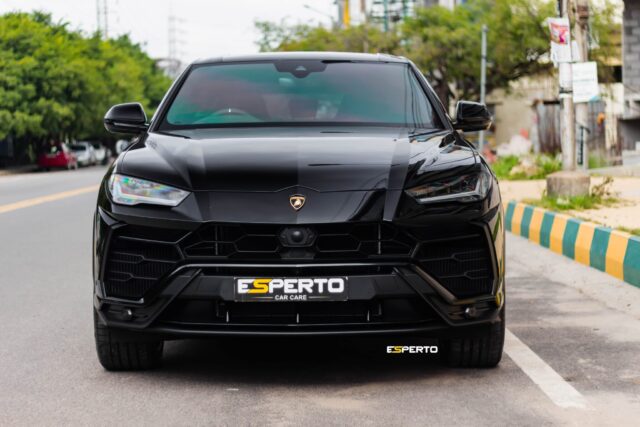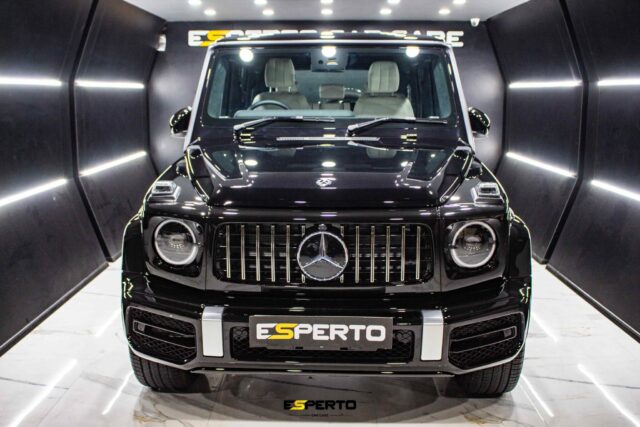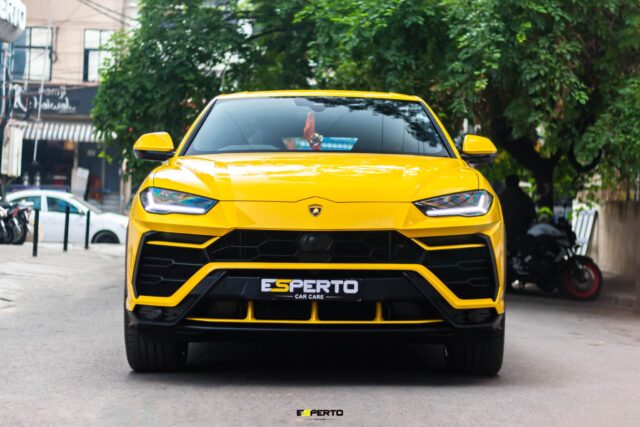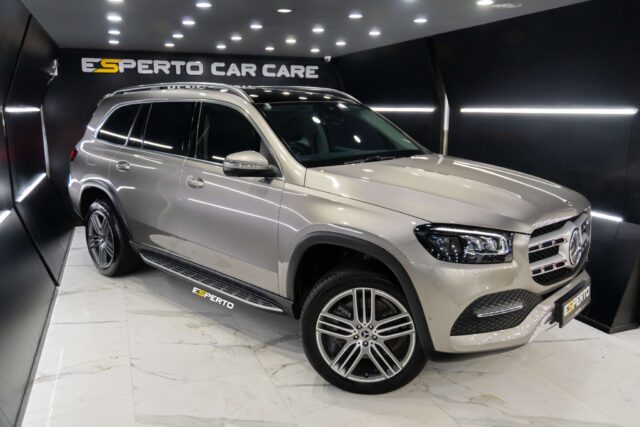How to Fully Apply Paint Protection Film (PPF) on Your Car: Step-by-Step Guide
Keeping your car looking shiny and new can be a challenge, especially with all the threats from the road, like rocks, salt, and other debris. You might be wondering how best to protect your car’s paint from these dangers.
Applying vehicle paint protection film solutions like paint protection film (PPF) is an intelligent solution that acts as a shield, keeping your vehicle’s paint safe from scratches and damages.
Did you know that PPF is not just a transparent layer, but this protective paint film also has self-healing properties? This means minor scratches can disappear completely, dry and on their own, under heat. In this article, we will guide you through each step for applying paint protection film correctly.
From preparing your car’s surface to maintaining the film for long-lasting results, we’ve got you covered. Ready to keep your car’s paint protected? Keep reading!
What is Paint Protection Film, and How Does It Work?
Paint Protection Film (PPF) is a high-quality thermoplastic urethane film that shields your car’s paint from scratches, chips, and environmental damage. This protective film bonds directly to the vehicle’s paint surface, creating a durable barrier against road debris, minor impacts, and harmful UV rays.
Unlike other protective options that may alter the appearance of your vehicle’s paint, PPF is transparent. It maintains the original look while offering long-lasting protection.
The real magic behind Paint Protection Film lies in its self-healing properties. When exposed to heat, minor scratches and swirls on the film disappear, ensuring the car’s paint looks pristine for years.
The PPF installation process involves precise cutting and application techniques to fit every curve of your vehicle perfectly. Whether you are applying PPF film yourself or opt for professional PPF installation, protecting your car’s paint from fading and damage has never been easier or more effective.
Understanding Paint Protection Film
Paint Protection Film (PPF), also called clear bra, is a durable material that protects your car’s front end, corners, and other vulnerable areas from scratches, chips, and stains caused by road debris and weather. It forms a transparent, seamless protective coating that keeps your vehicle’s appearance intact without altering its look.
The film bonds chemically to the paint, offering excellent protection and lasting up to 7 days after installation to set fully. If defects occur, such as lifting or bubbles, a reapply may be needed by professionals.
Considering the complexity and price, it’s wise to invest in professional installation for the best possible outcome. Proper care will help maintain your valuable investment and keep your car looking new longer.
PPF not only helps keep your vehicle’s aesthetics in tip-top shape but also retains its value over time by safeguarding the underlying paint from minor abrasions and UV exposure. With PPF fitted on your vehicle, it effectively mitigates paint damage while maintaining your car’s pristine condition.
How PPF Protects Your Car’s Paint
Paint Protection Film (PPF) acts as a shield for your car’s paint, guarding against everyday hazards. Rocks, road debris, and bug splatters pose no threat to the exterior of your vehicle thanks to PPF’s durable barrier.
This film is transparent, yet it provides a level of protection that keeps the original paint job looking fresh and new. Installing PPF on your vehicle prevents minor scratches and chips, which are common from regular use.
The science behind PPF offers long-lasting protection by bonding the film firmly to the surface of your car without damaging the underlying paint. Its self-healing properties work wonders on small abrasions, making them disappear under direct heat exposure from sunlight or an engine’s warmth.
With PPF applied, car owners can wash their cars without worrying about harming the paint. This innovative solution ensures that maintaining a pristine look for your vehicle is easier than ever before while also preserving its value over time.

The Science Behind PPF’s Long-Lasting Protection
The science behind paint protection film’s (PPF) long-lasting protection hinges on its unique composition and state-of-the-art technology. Automotive paint protection film acts as a durable barrier that shields your car’s paint from damage caused by rocks, road debris, UV rays, and minor scratches.
This innovative film is made of urethane or polyurethane material, allowing it to stretch and return to its original shape after absorbing impacts. Its top layer contains elastomeric polymers that help maintain the film’s effectiveness over years of use.
Applying the PPF creates an invisible shield over your vehicle’s body. This process involves cutting the film to fit precisely on various parts of your car, such as the front bumper, hood, and mirrors.
Once applied, this layer bonds with the paint surface through adhesives that ensure it stays intact without damaging the paint underneath. The quality of both the film and application determines how well it protects against environmental factors while preserving your car’s aesthetic appeal.
Regular maintenance can help extend its life even further, safeguarding your investment in automotive aesthetics for years down the line.
Why Should You Consider Applying PPF to Your Car?
Applying paint protection film (PPF) to your car offers a powerful shield against the elements and everyday wear. This clear bra acts as a durable barrier, protecting your car’s paint from scratches, rock chips, and harmful UV rays.
With paint protection film installed on the front of your vehicle or covering the entirety of the vehicle, you effectively protect the vehicle’s paintwork and maintain your car’s aesthetic appeal. The benefits of paint protection film include not just safeguarding against physical damage but also preserving the vehicle’s resale value.
As it reduces paint damage over time, cars with PPF tend to have higher resale values compared to those without.
Choosing the right PPF for your car involves understanding its quality and how thoroughly it protects the vehicle’s exterior surfaces before applying. Installation of paint protection film requires precision; ensuring that the entire surface itself is perfectly clean enhances its bonding capability and effectiveness over time.
Cars frequently exposed to harsh environments, especially benefit from this level of protection as it shields the paint from fading and discolouration due to sun exposure or acidic contaminants like bird droppings.
Whether you’re an avid car enthusiast or simply looking to preserve your investment, installing PPF is a wise decision for any vehicle owner wanting long-term preservation without compromising on looks.
Benefits of Paint Protection Film
Protecting your car’s paint is crucial for maintaining its appearance and value. Paint Protection Film (PPF), also known as clear bra, offers a durable barrier against scratches, chips, and environmental contaminants.
- Shields paint from scratches and dings: The film’s top layer absorbs impact from road debris, preventing it from leaving marks on your car’s surface.
- Preserves vehicle resale value: By keeping the paint in pristine condition, PPF maintains your car’s aesthetic appeal and can help retain its resale value over time.
- Reduces the need for costly paint repairs: By protecting the paint from damage, PPF minimizes the need for touch-ups and repaints, saving you money in the long run.
- Provides UV protection: PPF blocks harmful UV rays that can fade and discolour your car’s paint over time.
- Easy to clean and maintain: Dirt and debris do not stick to the film quickly, making car washes more effective and less frequent.
- Self-healing technology: Many high-quality PPF films come with self-healing properties that make minor scratches disappear under heat from the sun or hot water.
- Enhances gloss or matte finishes: High-quality PPF can accentuate the gloss of your vehicle’s paint or provide a stylish matte finish if preferred.
- Customizable coverage options: You can choose to apply PPF to high-impact areas like the front bumper or cover the entire vehicle for maximum protection.
- Acts as a barrier against chemical stains: PPF prevents spots from bird droppings, tree sap, and other corrosive substances from etching into your car paintwork protection film.
Protecting Your Car’s Paint from Scratches
Your car’s paint needs protection from scratches and the elements. Paint Protection Film (PPF) is a durable sacrificial layer that shields your vehicle from light scratches, preserving its finish and preventing long-term damage. This film guards against rocks, road debris, and minor abrasions that can damage the vehicle’s surface further. It’s especially useful around wheels, side mirrors, and headlights, where impacts are more frequent.
Applying PPF helps to keep your car looking new for longer, making it a valuable investment for preserving your vehicle’s aesthetic and resale value, often lasting up to 10 years with proper care.
Installing paint protection film on your vehicle involves careful steps. First, you must begin by thoroughly cleaning and preparing the surface using a water solution or solvent-based cleaners to wipe away dirt, oils, or debris quickly. This ensures a flawless application and proper adhesion.
Next, position the paint protection film accurately, then gently lift and stretch it over the target area to contour around curves and edges. Dealing with tight spots like around the side mirrors may require extra attention. Once in place, trimming any excess film ensures a smooth, seamless finish without harming the paint beneath the liner film.
This process involves several factors, such as surface prep, material quality, and installation technique, all of which impact the result. For the best possible outcome, it’s often advisable to consult professionals who can inform you of product options and application tips.
How to Prepare Your Car for PPF Installation
Preparing your car for paint protection film (PPF) installation is crucial to ensure the best results. A clean and smooth surface allows the PPF film to bond properly and protects your car’s paint effectively.
- Thoroughly wash your car to eliminate dirt, dust, and grime from its surface, using a high-quality car shampoo that’s gentle on the paint.
- Dry your vehicle entirely with a microfiber towel or air blower, ensuring no water remains on the surfaces where PPF will be applied.
- Apply a clay bar treatment over the entire car to remove any contaminants that washing cannot eliminate, such as tar, sap, or embedded dirt particles.
- Perform paint correction if necessary to fix any scratches or swirl marks on the paint. This step ensures that the film lays flat and looks sleek once installed.
- Wipe down all surfaces with an isopropyl alcohol solution or a pre-installation cleaner specially formulated for PPF application. This step removes any oils or residues that could prevent good adhesion.
- Inspect the car’s paint surface closely in good lighting to identify any imperfections missed during cleaning and correction steps.
- Gather all tools and materials required for applying paint protection film: squeegee, sharp blades for trimming excess film, slip solution for positioning the film, and a heat gun to stretch it when needed.
Ensuring every detail is accounted for during preparation will set you up for success in the next stages of PPF installation.
Pre-Installation Car Wash and Paint Correction
Before you apply paint protection film (PPF) to your car, a thorough car wash and paint correction are crucial. These steps ensure that the PPF bonds properly to your car’s surface without trapping dirt or imperfections. Here’s how to prepare your vehicle:
- Wash your car with a high-quality car shampoo. Remove all dirt, grime, and residues from the road.
- Dry the vehicle completely with microfiber towels to avoid water spots.
- Use a clay bar on the entire body of the car. This removes embedded contaminants from the paint surface.
- Inspect the paint for scratches and swirl marks that need correcting.
- Apply a compound to address deeper scratches, using a dual-action polisher for even application.
- Follow up with a finer polish to smooth out any remaining imperfections and enhance the paint’s shine.
- Clean the surface with isopropyl alcohol (IPA). This step ensures no polishing oils remain that could prevent the PPF from adhering correctly.
- Carefully inspect the surface one last time for any missed spots or remaining blemishes.
Each of these steps plays a vital role in preparing your vehicle for PPF installation, making sure it provides maximum protection and aesthetic enhancement for your car’s paint.
Ensuring a Clean Surface for PPF Application
Following a thorough car wash and paint correction, ensuring a clean surface for PPF application is crucial. This step removes any remaining contaminants that could prevent the paint protection film from properly bonding to the car’s surface. Experts use specialized cleaners and installation gel during the application process to prep the area, focusing on getting rid of oils, dust, or residue.
Experts use specialized cleaners to prep the area, focusing on getting rid of oils, dust, or residue. This guarantees that the PPF adheres to ceramic coating more smoothly and lasts longer. Choosing from various PPF options, which vary in thickness, finish, and resistance to corrosion or discolouration, allows for a tailored approach that suits the vehicle’s needs. Most high-quality films are highly durable, often made with a combination of elastomeric polymers designed to withstand harsh elements.
After a thorough cleaning, it becomes necessary to inspect for any signs of dirt or imperfections. Even tiny particles can cause bubbles or wrinkles, compromising the virtually invisible look that PPF aims to achieve. This inspection makes a difference in how well the film protects and enhances your car’s colour and finish.
The goal here is not just cleanliness but perfection; ensuring every inch of the surface meets high standards before applying PPF helps refrain from issues that could require early removal or reapplication. After application, it’s best to wait the recommended curing time to ensure optimal results. Proper prep and installation lead to a strong aegis over your vehicle’s paint, offering lasting protection and enhancing long-term appeal.
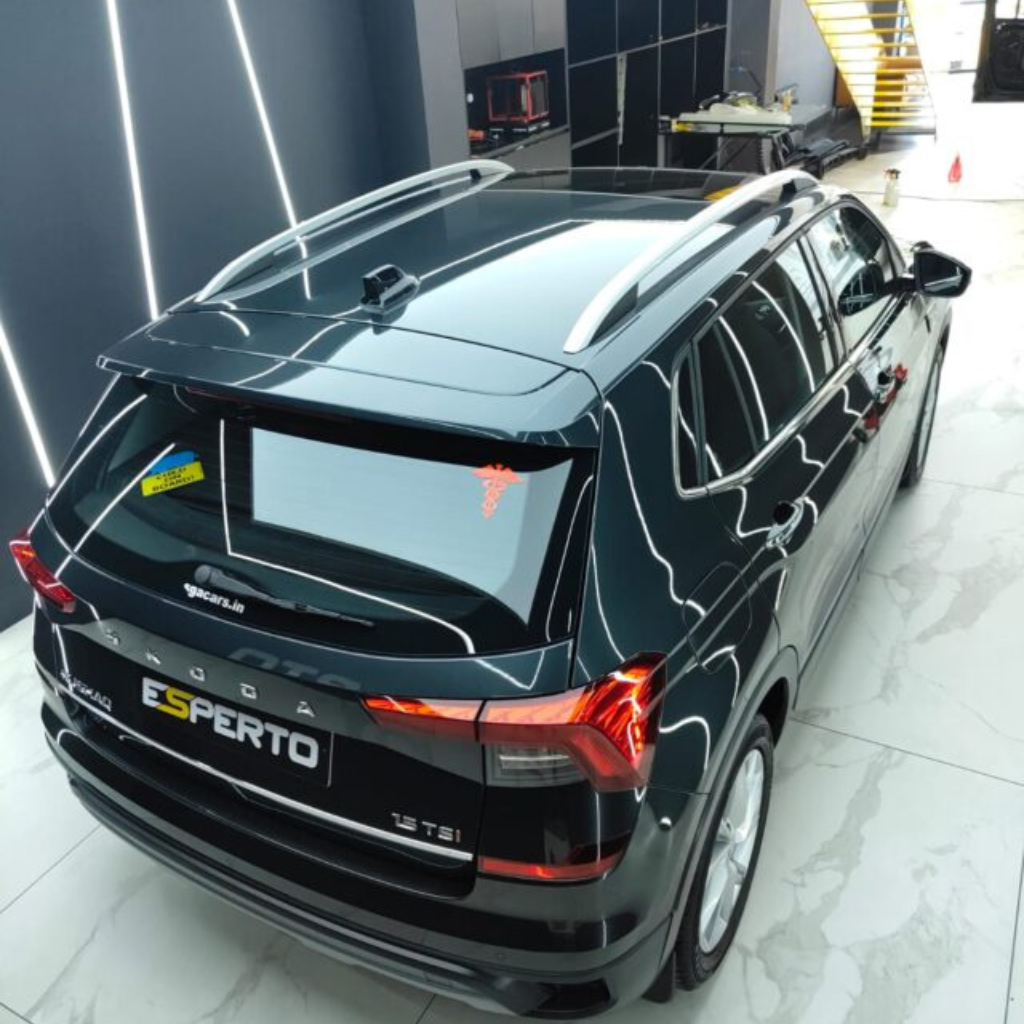
Inspecting the Car’s Paint Surface
Before applying Paint Protection Film (PPF) to your car, it’s vital to inspect the paint surface for any signs of damage or deterioration, such as scratches, dings, or rust spots. This step is especially important in areas prone to impact, like door edges, where imperfections can affect the film’s adhesion. The application quality of the film directly correlates with the condition of the surface it adheres to.
Any surface flaws must be corrected before installing the PPF. For new cars, this typically involves less corrective work, but it’s still essential to verify the integrity of the clear coat. The preparation process includes thoroughly washing the car to remove dirt, using a soap solution, and making any necessary paint corrections.
A sealant solution may also be applied to promote bonding and longevity. This guarantees the PPF, made from durable material, bonds optimally with your car’s paint, forming a protective coating that offers excellent protection against external elements like rocks and road debris.
A meticulously performed application enhances the vehicle’s appearance, delivering a flawless finish. Regular post-installation check-ups will help maintain the film’s condition and extend its durability, ensuring your car retains a fresh, protected look for years to come.
Step-by-Step Guide to Applying Paint Protection Film
Applying paint protection film (PPF) to your car is a great way to protect its paint from the elements and everyday wear. This guide will show you the step-by-step process of applying PPF, ensuring that the paint on your vehicle remains pristine.
- Gather all necessary tools and materials. This includes the best paint protection film you can find, a squeegee, a sharp knife for trimming excess film, a spray bottle filled with soapy water, and cleaning soft cloths.
- Wash your car thoroughly. Ensure you remove all dirt and grime from the surface. A clean surface is crucial for proper PPF application.
- Conduct paint correction if necessary. Removing any swirl marks or scratches ensures that the film adheres smoothly and looks its best.
- Inspect the car’s paint surface carefully. Look for any signs of damage or imperfections that might need addressing before you put on the PPF.
- Cut the film to fit your car’s dimensions. Measure and trim any excess film, but leave a little extra just in case adjustments are needed during application.
- Apply a wetting solution to your car’s surface by spraying it generously with soapy water from your bottle. This step helps in positioning and stretching the film without it sticking prematurely.
- Position the PPF on the target area of your vehicle, starting from one end. Use your hands to smooth out the film as much as possible before using any tools.
- Stretch the film gently to remove bubbles and wrinkles, ensuring that it fits perfectly over curves and edges without damaging the paint beneath.
- Use a squeegee to push out any remaining air bubbles and ensure that the PPF bonds well with your car’s surface.
- Trim any excess film carefully with a sharp knife, making precise cuts to ensure that only what is needed remains on your vehicle.
- Apply heat with a heat gun sparingly along edges or curved areas where the PPF needs to conform tightly around shapes for perfect adherence.
- Inspect ppf for any signs of lifting or air pockets after installation, pressing down firmly on any problematic areas until secure.
These steps help install Paint Protection Film effectively on any vehicle, protecting its aesthetics while ensuring durability against wear and damage from daily use or exposure to harsh environmental elements. But can you install paint protection film yourself? While DIY installation is possible, professional application is recommended for the best results and to avoid common issues like bubbles or misalignment.
Gathering the Necessary Tools and Materials
Starting the process of applying paint protection film (PPF) to your car requires organization and preparation. You’ll need specific tools and materials to ensure the installation process goes smoothly and that the PPF adheres properly to your vehicle’s surface.
- Cutting Tools: Obtain a high-quality precision knife or blade. This will help you trim the excess film without damaging your car’s paint.
- Squeegees: A set of squeegees is essential for smoothing out the film and ensuring it bonds well with the paint surface.
- Slip Solution: Prepare a slip solution by mixing baby shampoo with water. This solution aids in positioning the film on your car’s surface before it adheres.
- Isopropyl Alcohol (IPA) Solution: An IPA solution, typically a mix of 70% alcohol and 30% water, is crucial for cleaning surfaces before applying PPF.
- Microfiber Towels: Have several clean microfiber towels at hand to clean your car’s surface and handle the film without leaving fingerprints or dust.
- Heat Gun: A heat gun helps stretch the film during application, making it easier to conform to curved surfaces.
- Clay Bar: Use a clay bar to deep clean your car’s paint and ensure it is completely smooth before PPF installation.
- Gloves: Wear nitrile gloves to avoid contaminating the film or your car’s paint with oils from your fingers.
- Tape Measure: Use a tape measure for precise cuts so that the PPF fits each section of your vehicle accurately.
- Water Spray Bottle: Keep a spray bottle filled with water handy to help adjust and position the film during installation.
Having these tools and materials ready sets up a strong foundation for successful PPF application, keeping your vehicle looking newer and longer by protecting its paint from scratches, chips, and environmental contaminants.
Positioning and Stretching the Film
Applying paint protection film (PPF) to your vehicle is a crucial step in preserving its aesthetics. Proper placement and stretching of the film ensures it fuses seamlessly with your car’s contours, offering long-lasting, sturdy protection.
- Thoroughly clean the surface of the vehicle before starting. Any dirt or debris can hinder the PPF from sticking correctly.
- Determine the area where you’ll install PPF to cut the film with precision. This avoids unnecessary waste of material.
- Use a liquid mixing of water and baby shampoo to moisten the surface of your car. This assists in placing the film without it sticking instantly.
- Remove the backing of the PPF slowly to avoid wrinkles or folds.
- Carefully place the film on the desired area, commencing from one end and gently laying it down on the other end.
- Utilize a squeegee to evenly stretch the film across the surface, eliminating air bubbles and ensuring flawless adhesion.
- Apply a stronger tack solution, more potent than a slip solution, around edges and curved zones for a durable bond that endures longer.
- Neatly trim any excess film using a sharp knife while being careful not to damage your car’s paint.
- A heat gun can be subtly used on intricate curves or edges to render PPF more adaptable for stretching without tearing.
- After installation, thoroughly scrutinize your work for any air bubbles, crinkles, or misaligned edges and promptly rectify these issues.
Adhering to these instructions ensures that PPF is appropriately applied, prolonging its durability and enhancing the protection of your car’s paint against scratches and environmental harm.
Trimming Excess Film Without Damaging the Paint
Applying paint protection film (PPF) requires precision, especially during the trimming and cleaning process. The goal is to protect your car\’s paint while getting rid of extra PPF without leaving any marks or cuts.
- Use a sharp utility knife designated for PPF installation to ensure clean cuts.
- Keep the blade angle shallow – a steep angle increases the risk of cutting into the paint.
- Cut away from the car’s body whenever possible to minimize potential damage.
- Use masking tape along the edges as a guide to prevent slipping and marking the paintwork.
- Start with a small incision and gently pull the excess film, applying light pressure with the knife as you go.
- Regularly replace blades to maintain sharpness; dull blades can tear the film or scratch the paint.
- Practice on scrap pieces of PPF before attempting it on your car to gain confidence and steadiness.
- Ensure sufficient lighting over your working area to see all edges and cut lines clearly.
- Use a squeegee to smooth down the edges after trimming for a seamless finish.
- Lastly, always double-check for any missed spots or uneven lines that may need re-trimming.
With these steps, you can trim excess PPF effectively, providing your vehicle with durable barrier protection that looks as good as new.
DIY PPF Installation: Which is Right for You?
Choosing between professional service or DIY for PPF installation is a critical decision for car owners, bikers, and automobile fanatics. Professional service comes with perks like expert insight, a supply of high-quality materials, and an assurance that the car’s paint protective film appropriately adheres to the car’s surface.
These pros make sure that your vehicle receives optimal protection against scuffs and weather-induced harm without jeopardising the well-being during the application procedure. Experts are also skilled at correctly applying PPF to suit every twist and turn of your vehicle, ensuring a flawless finish.
Conversely, DIY PPF installation can be a fulfilling and economical choice for those who enjoy maintaining and repairing their vehicles. It affords you the opportunity to learn the process of car paint protection film installation directly, whilst also saving on labour costs.
But it demands patience, an eye for minute details, and a time commitment. Advice like maintaining a clean surface before paint protection film application and employing the appropriate tools is critical to evade common missteps that might spoil your car’s paint or result in unattractive bubbles underneath the film.
For many hobbyists, this process brings a sense of achievement along with efficient protection.
Advantages of Professional PPF Installation
Professional PPF installation provides several advantages, including a level of precision and durability that DIY methods struggle to match. Experts ensure the film bonds seamlessly with your car’s surface, offering optimal protection.
- Professional installers use advanced techniques to ensure the paint protection film adheres properly to every contour of your vehicle, minimizing bubbles and wrinkles.
- They have access to high-quality materials that might not be available to the average consumer, resulting in a more effective and long-lasting barrier against scratches and UV damage.
- Installers bring years of experience, meaning they can apply PPF on the front bumper, hood, mirrors, and other vulnerable areas quickly and efficiently.
- With professional installation, you get a warranty not just on the film but also on the labour. If issues arise, you’re covered.
- Experts know exactly how to trim excess film without damaging your car’s paint – a task that requires precision tools and a steady hand.
- Professionals perform thorough pre-installation prep work, including washing and correcting any existing paint flaws for an impeccable finish.
- They can advise you on the best type of paint protection film for your car’s specific needs, whether it’s full body coverage or focused protection for high-impact areas.
The right choice between professional installation and DIY depends on individual preferences and skills.
When to Seek Professional Help
Seeking professional help for the installation of PPF on your car is crucial if you lack the experience or tools. A trained detailer uses advanced techniques to ensure the proper application of the paint protection film, preventing air bubbles, repositioning errors, and misalignment that can compromise your vehicle’s aesthetics and clarity.
Professionals have access to high-quality, crafted films that offer durable barriers against scratches, environmental damage, and general wear. They pay special attention to intricate areas like the fender, curves, and tight spots, ensuring smoothness and seamless coverage. Their ability to wrap every contour of your vehicle with precision ensures a consistent and effective protective layer.
Moreover, professional installers understand how to manage film availability, installation timing, and curing for the best outcome. This level of expertise leads to a flawless finish that maintains your car’s shine while offering long-lasting defense.
Ideally, opting for professional installation guarantees peace of mind, knowing your investment is in capable hands. You’ll discover the real value in having experts protect your car’s finish—both visually and functionally—for years to come.
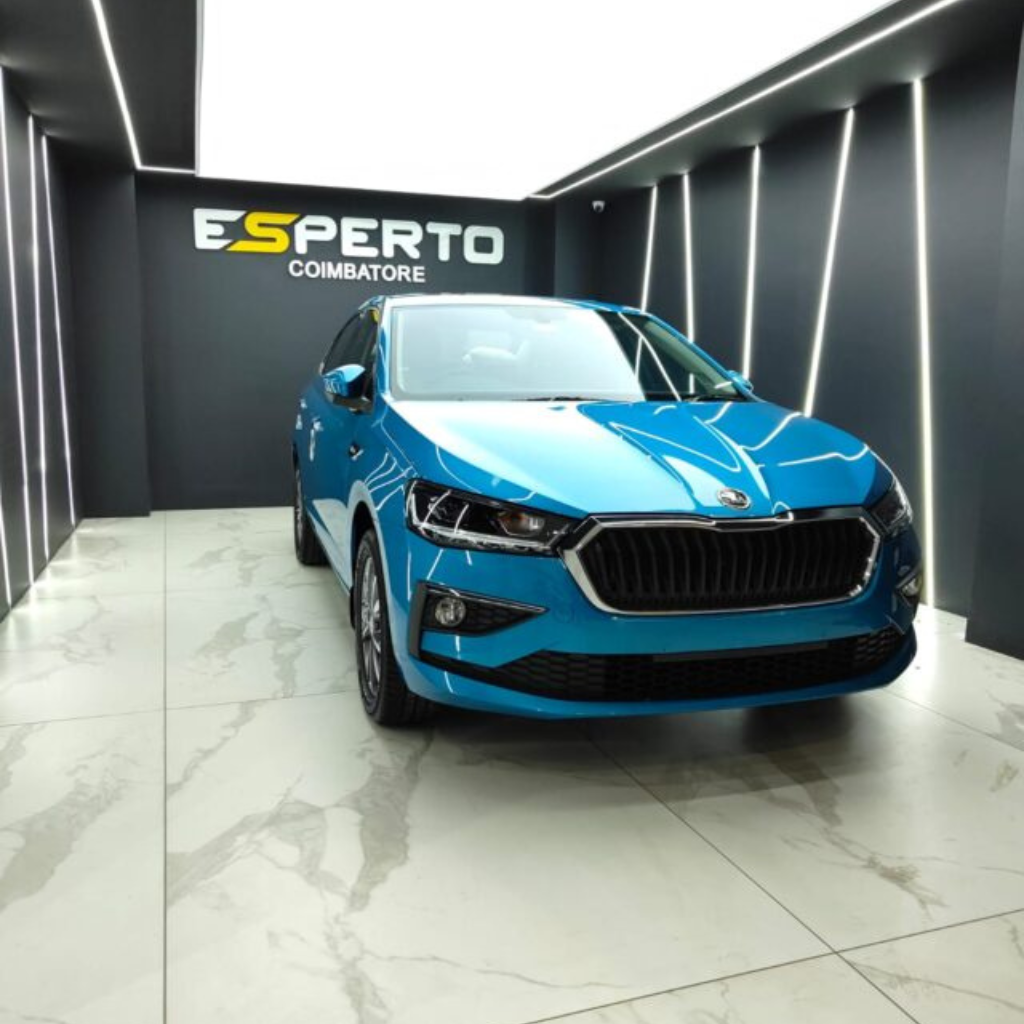
Maintaining Your Paint Protection Film for Longevity
Regular washing and maintenance are key to extending the life of your paint protection film (PPF). You should wash your car regularly, ideally every two weeks, using a clean microfiber cloth and mild detergent. This practice prevents dust particles and natural contaminants from building up, which can scratch the thin layer of the film over time.
Avoid harsh chemicals that might damage the PPF coating or ceramic layer applied on top, especially if you’ve opted for matte PPF, which requires extra care to maintain its finish. Washing your car helps maintain the protective barrier that PPF helps maintain against harmful contaminants.
Inspecting your PPF regularly for any signs of wear or damage is crucial. Look out for lifting edges or bubbling, which may compromise the film’s effectiveness. If you notice small scratches or nicks, don’t panic—both PPF different types (gloss and matte) are designed to heal themselves under heat from direct sunlight or a warm engine.
For larger issues or persistent defects, consult professional PPF installers who can properly assess whether a section needs repair or replacement. These specialists follow the manufacturer’s instructions carefully, ensuring the longevity and performance of the film. Keep in mind that results may vary depending on installation quality, driving conditions, and care habits.
Following these steps will ensure your car’s paint remains protected for years to come, making PPF a wise investment for preserving your vehicle’s appearance.
Regular Car Wash and Maintenance Tips
Maintaining your car with regular washes and upkeep plays a vital role in protecting its appearance and longevity. Especially for those with paint protection film (PPF), applying proper maintenance and care ensures the film remains effective in shielding your vehicle’s paint from scratches and environmental damage.
- Wash your car every two weeks using a mild soap designed for automotive use. This prevents dirt from accumulating and potentially scratching the paint or PPF.
- Apply a silicone-based wax to the PPF every six months to maintain its glossy finish and further protect the car’s exterior.
- Inspect your PPF regularly for any signs of wear or damage, like peeling edges or scratches. Early detection allows for prompt repairs, preventing further issues.
- Avoid parking under trees for extended periods to prevent sap or bird droppings from staining the film. These contaminants can etch into the PPF if left uncleaned.
- Use a soft microfiber cloth for washing and drying your car to avoid introducing scratches to the paint or film.
- Keep your vehicle away from abrasive cleaning tools such as stiff brushes or scouring pads that can damage the surface of the PPF.
- If you notice any debris like tar or bugs stuck on the film, gently remove it using a designated automotive adhesive remover, followed by a thorough wash.
- Ensure you’re parking indoors or under cover whenever possible to minimize exposure to UV rays, which can degrade the film over time.
- After each wash, check the seals and edges of the film for lifting or bubbling, which can cause moisture and dirt underneath, compromising its protective qualities.
- Store a maintenance kit in your garage consisting of recommended soaps, waxes, microfiber cloths, and adhesive removers specifically designed for cars with paint protection films to ensure you always have the right products on hand.
How to Handle Film Damage or Wear
Handling film damage or wear starts with regular inspections. You must check your paint protection film (PPF) for any signs of lifting, peeling, or scratches. These areas are especially common near door handles, window edges, and different parts of the vehicle exposed to frequent contact. If you spot PPF damage early, you can often prevent further damage and other damage to your car’s paintwork.
For minor scratches, heat often heals the PPF due to its self-healing properties, which come from the elastomeric polymer film that gives it flexibility and durability. Use a hairdryer or let the vehicle sit in the sun during the day—this method allows the film to regain its original form with ease.
It’s important to remember that while minor issues can often be addressed at home, deeper damage, such as tears, deep cuts, or bubbling, generally takes more attention. Replacing more film might be necessary in those areas. Attempting a DIY fix without experience can lead to further damage. For the best possible protection, professionals recommend replacing sections as needed to maintain overall integrity.
A number of people attempt home repairs, but if you’re unsure how to handle it properly, it’s wise to follow expert recommendations. The fact is that professional installers can delve deeper into assessing the damage and preserving your paint. This is especially relevant if your vehicle sees regular wear and tear, where a quality job makes all the difference.
Maximizing the Life of Your PPF
In terms of managing film degradation or wear, it’s imperative to centre strategies that extend the longevity of your vehicle’s paint protection film (PPF). Care for PPF goes beyond addressing concerns; it incorporates consistent upkeep to extend its lifetime and maintain the integrity of your vehicle’s finish.
Systematic washing and cleaning are important in retaining the defensive attributes of the film. Pay close attention to using gentle, non-abrasive detergents and steer clear of high-pressure washers, which can easily cause lift lines or weaken the bond, especially around edges or curves, regardless of your car’s model or size.
To keep your PPF film functioning optimally, apply wax or sealant exclusively designed for these films every few months. This addition provides an extra layer of protection against contaminants and UV rays, which are important factors that could otherwise lead to yellowing or deterioration. Be sure to explore products that are activated specifically for paint protection film to avoid using the wrong contents that may compromise performance.
PPF maintenance may seem difficult at first, but with enough time, it becomes a simple routine. While the installation time may vary by vehicle type and film variety, the investment is well worth it to avoid expensive repainting jobs later. Giving your PPF the best time to cure after application, along with routine care, means you’ll live with a car that looks newer, longer.
Professionals may charge differently depending on the region or service package, but keeping your PPF in top shape doesn’t always have to be expensive—it’s one of those things that, when done right, pays off in the long run.
Conclusion
The process of applying paint protection film to a car acts as a buffer against scratches and damage. Our manual streamlines the process, making it straightforward and efficient.
This technique helps sustain your automobile’s look while also keeping its value intact. Should you need more assistance, professional help such as that offered by vehicle maintenance specialists is an option.
Adopting this measure ensures your car remains pristine and enhances its lifespan, serving as a smart decision for vehicle owners.



